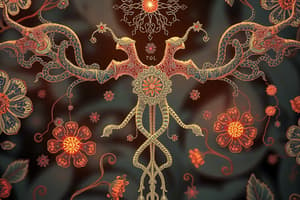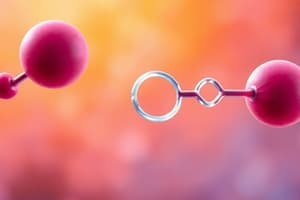Podcast
Questions and Answers
What are the two main types of hormones based on their biochemical composition?
What are the two main types of hormones based on their biochemical composition?
- Vitamins and Minerals
- Peptides/proteins and Steroids/Fatty acid derivatives (correct)
- Proteins and Nucleic acids
- Carbohydrates and Lipids
Peptide hormones can diffuse freely across cell membranes.
Peptide hormones can diffuse freely across cell membranes.
False (B)
How are peptide hormones produced?
How are peptide hormones produced?
Through translation and transcription from a gene.
Steroid hormones are synthesized through multi-step, _______ processes.
Steroid hormones are synthesized through multi-step, _______ processes.
Which of the following is a precursor for the synthesis of steroid hormones?
Which of the following is a precursor for the synthesis of steroid hormones?
The production of peptide hormones can be up or down regulated.
The production of peptide hormones can be up or down regulated.
Which of the following is true about steroid hormones?
Which of the following is true about steroid hormones?
Match the following precursor molecules with the resultant hormones:
Match the following precursor molecules with the resultant hormones:
What is the first enzymatic step in steroid synthesis?
What is the first enzymatic step in steroid synthesis?
The enzyme that catalyzes the conversion of cholesterol to pregnenolone is located in the outer mitochondrial membrane.
The enzyme that catalyzes the conversion of cholesterol to pregnenolone is located in the outer mitochondrial membrane.
What is the rate-limiting step in the conversion of cholesterol to pregnenolone?
What is the rate-limiting step in the conversion of cholesterol to pregnenolone?
The protein responsible for transporting free cholesterol into mitochondria is called ______.
The protein responsible for transporting free cholesterol into mitochondria is called ______.
Match the old P450 names with their current CYP names:
Match the old P450 names with their current CYP names:
Does more production/synthesis of a peptide hormone always mean more secretion?
Does more production/synthesis of a peptide hormone always mean more secretion?
Changes in plasma concentration of a hormone always represent changes in secretion.
Changes in plasma concentration of a hormone always represent changes in secretion.
Which of the following is NOT a characteristic of hormone assays?
Which of the following is NOT a characteristic of hormone assays?
When validating an assay, what is the primary reason to test the antibody against different hormones?
When validating an assay, what is the primary reason to test the antibody against different hormones?
Immunoassays directly measure the biological activity of hormones.
Immunoassays directly measure the biological activity of hormones.
If a plasma sample has a hormone concentration below the assay's detection limit, what problem does this present?
If a plasma sample has a hormone concentration below the assay's detection limit, what problem does this present?
Antisera used in immunoassays must be both ______ and specific.
Antisera used in immunoassays must be both ______ and specific.
Match the following techniques with their application in hormone measurement:
Match the following techniques with their application in hormone measurement:
What is the primary function of antisera in hormone detection?
What is the primary function of antisera in hormone detection?
In a competitive binding assay, the amount of antibody is variable.
In a competitive binding assay, the amount of antibody is variable.
What is measured in a competitive binding immunoassay after the free hormone is removed?
What is measured in a competitive binding immunoassay after the free hormone is removed?
In an immunoassay, a standard curve shows a direct relationship between hormone concentration and the amount of ______.
In an immunoassay, a standard curve shows a direct relationship between hormone concentration and the amount of ______.
Match the following validation steps for a hormone assay with their description:
Match the following validation steps for a hormone assay with their description:
In a competitive binding assay, what competes for the limited antibody?
In a competitive binding assay, what competes for the limited antibody?
The second antibody used in some immunoassays is labeled.
The second antibody used in some immunoassays is labeled.
What are the three steps to validate a hormone assay?
What are the three steps to validate a hormone assay?
Flashcards
What is a hormone?
What is a hormone?
A regulatory substance produced in an organism and transported in tissue fluids such as blood to stimulate specific cells or tissues into action.
What are the two main types of hormones based on their biochemical composition?
What are the two main types of hormones based on their biochemical composition?
Peptides or proteins are hydrophilic, relatively large, synthesized from mRNA, stored in vesicles, bind to cell membrane receptors, and can't cross membranes. Steroids and fatty acid derivatives are hydrophobic, relatively small, synthesized through multi-step enzyme processes, not stored, cross membranes, and bind to intracellular or membrane receptors.
How are peptide hormones produced?
How are peptide hormones produced?
Peptide hormones are synthesized through translation and transcription from a gene.
Is it possible to up or downregulate a peptide hormone production?
Is it possible to up or downregulate a peptide hormone production?
Signup and view all the flashcards
What is post-translational modification?
What is post-translational modification?
Signup and view all the flashcards
How are steroid hormones and fatty acid derivatives synthesized?
How are steroid hormones and fatty acid derivatives synthesized?
Signup and view all the flashcards
Can we up or downregulate a steroid hormone production?
Can we up or downregulate a steroid hormone production?
Signup and view all the flashcards
What is the relationship between ghrelin, obestatin, and POMC?
What is the relationship between ghrelin, obestatin, and POMC?
Signup and view all the flashcards
First enzymatic step in steroid synthesis
First enzymatic step in steroid synthesis
Signup and view all the flashcards
Rate-limiting step in steroid synthesis
Rate-limiting step in steroid synthesis
Signup and view all the flashcards
Steroid biosynthesis enzymes
Steroid biosynthesis enzymes
Signup and view all the flashcards
Biological assay (bioassay)
Biological assay (bioassay)
Signup and view all the flashcards
Endocrine assay
Endocrine assay
Signup and view all the flashcards
Biological hormone measurement
Biological hormone measurement
Signup and view all the flashcards
Immunological hormone measurement
Immunological hormone measurement
Signup and view all the flashcards
Chemical hormone measurement
Chemical hormone measurement
Signup and view all the flashcards
Antisera
Antisera
Signup and view all the flashcards
Sensitivity of an immunoassay
Sensitivity of an immunoassay
Signup and view all the flashcards
Specificity of an immunoassay
Specificity of an immunoassay
Signup and view all the flashcards
Competitive Binding Immunoassay
Competitive Binding Immunoassay
Signup and view all the flashcards
Validation of an immunoassay
Validation of an immunoassay
Signup and view all the flashcards
Parallelism in immunoassay validation
Parallelism in immunoassay validation
Signup and view all the flashcards
Recovery in immunoassay validation
Recovery in immunoassay validation
Signup and view all the flashcards
Cross-reactivity in immunoassay validation
Cross-reactivity in immunoassay validation
Signup and view all the flashcards
Antibody Specificity
Antibody Specificity
Signup and view all the flashcards
Assay Detectable Limit
Assay Detectable Limit
Signup and view all the flashcards
Immunoassay
Immunoassay
Signup and view all the flashcards
Cross-Reactivity
Cross-Reactivity
Signup and view all the flashcards
Chemical Methods
Chemical Methods
Signup and view all the flashcards
Study Notes
Hormone Definition
- Hormones are regulatory substances produced in an organism and transported in tissue fluids (like blood) to stimulate specific cells or tissues.
- They are produced by one tissue and carried by the bloodstream to another tissue to influence physiological activity, such as growth or metabolism.
Hormone Biochemistry
- Hormones are composed of different biochemical components.
- Some hormones are peptides or proteins, hydrophilic molecules with relatively large molecular weight, and synthesized through mRNA-directed processes. They are stored in membrane-bound vesicles and cannot readily diffuse across cell membranes. They interact with receptors in cell membranes.
- Other hormones are steroid or fatty acid derivatives, hydrophobic molecules with relatively small molecular weight. They are synthesized through multi-step enzyme-mediated processes and are not stored in signaling cells. They readily cross cell membranes and interact with intracellular or membrane receptors.
Peptide Hormone Production
- Peptide hormones are produced through translation and transcription from a gene, or from other proteins.
Up/Downregulation of Peptide Hormone Production
- Peptide hormone production can be upregulated (increased) or downregulated (decreased).
Hormone Processing
- Hormones (especially peptides) are processed within an endocrine cell. This involves several steps: synthesis, prohormone packaging, prohormone processing, hormone storage, and hormone secretion.
Ghrelin and Obestatin
- Ghrelin is a peptide hormone involved in stimulating appetite.
- Obestatin is another peptide hormone associated with decreasing appetite.
Steroid and Fatty Acid Derivatives
- Steroid and fatty acid derivatives are produced through several steps, often multi-step processes.
- Examples of these derivatives include: prostaglandins, thromboxanes, leukotrienes, progesterone, estradiol, and testosterone. Fatty acid derivatives include arachidonic acid.
Cholesterol Metabolism and Steroid Production
- The first step in steroid synthesis involves the conversion of cholesterol to pregnenolone.
- This conversion occurs in the inner mitochondrial membrane.
- The rate-limiting step is the transport of cholesterol from the cytoplasm to the mitochondria. This is carried out by the Steroidogenic Acute Regulatory Protein (StAR).
Steroid Synthesis
- The synthesis of steroids involves multiple steps and enzymes as depicted in the diagrams.
Enzyme Names and "Old" Names
- There are specific enzymes involved in the synthesis of steroid hormones. These enzymes have names, as well as older names that may be used in some contexts.
Steroidogenic Enzymes
- Some key enzymes involved in steroid hormone synthesis (Aromatase, 450scc) and their related names are provided.
Biochemistry of Hormones - Questions and Answers
- The presentation asks several questions about the relationship between hormone concentration/production and secretion, with the suggested answer of "yes" for most of them.
Hormone Measurements - General Methods
- Three methods are used for measuring hormones: biological, immunological, and chemical.
- Biological methods involve measuring how the hormone affects a target organ or tissue.
- Immunological and chemical methods, including chromatography and mass spectrometry, measure aspects of the hormone's chemical structure or composition.
Biological Assay Examples
- Several hormones, and assay systems to test them, have been provided, along with methods used to evaluate them.
Immunoassay Principles and Ingredients
- Immunoassays measure hormones via specialized chemical reactions that utilize antibodies and labeled hormones.
- Key factors to consider in immunoassays are the specificity of the antibodies and the sensitivity.
- The method uses the principle that the quantity of a hormone can be identified by measuring the endpoint signaling.
Competitive Binding Assay
Examples, diagrams, and detailed explanation of competitive binding assay are included. This method includes standards to relate to the samples.
Antigen Capture Assay
- This assay involves a similar approach to measures the levels of hormones.
Validation of an Assay
- Assay validation involves three steps: parallelism, recovery, and cross-reactivity. Parallelism assesses whether dilutions of the sample will produce a similar response to dilutions of the standard. Recovery measures the correct detection of the target hormone in the presence of a known standard. Cross-reactivity evaluates whether there is any overlap or other hormones/factors that can interact with the test.
Common Problems with Immunoassays
- Factors to consider when using immunoassay methods include the sensitivity and specificity of hormone detection as well as the challenges of the lack of antibodies that recognize certain hormones.
Chemical Methods
- These methods for measuring hormones are used when biological or immunological methods are not available, evaluating unique aspects of hormones such as their chemical composition. These methods usually use specialized chemicals, such as chromatography and mass spectrometry.
Studying That Suits You
Use AI to generate personalized quizzes and flashcards to suit your learning preferences.




